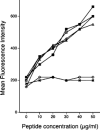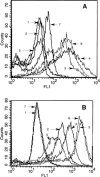Recognition of PSA-derived peptide antigens by T cells from prostate cancer patients without any prior stimulation
- PMID: 12783216
- PMCID: PMC11032962
- DOI: 10.1007/s00262-003-0377-8
Recognition of PSA-derived peptide antigens by T cells from prostate cancer patients without any prior stimulation
Abstract
Prostate-specific antigen (PSA) is a valuable marker antigen for prostate cancer. Lately considerable interest has been generated in the prospect of developing a vaccine for prostate cancer with PSA-derived peptide epitopes to induce cytotoxic T-cell (CTL) response. We report here that T cells capable of exhibiting PSA epitope-specific effector function-in their native state, i.e, without having to be further stimulated, in vitro-are detectable in more than half of the prostate cancer patients we studied. Ex vivo cultured autologous dendritic cells (DC) were used to present four HLA-A2-binding PSA peptide epitopes to freshly isolated peripheral blood lymphocytes (PBL) from patients and healthy volunteers. Ten out of 14 patients' PBL recognized at least one of the four peptides and 6 out of 10 patients' PBL recognized more than one peptide antigen as measured by IFN-gamma secretion upon stimulation of the PBL with the peptide antigen. Intracytoplasmic cytokine analysis for IFN-gamma in purified CD8(+) cells after stimulation with peptide antigens was tested in 6 patients and this technique demonstrated a similar response. Freshly isolated and purified CD8(+) cells when tested, also recognized the epitopes, as measured by IFN assay, when presented by transporter associated with antigen-processing (TAP) deficient T2 cells in an MHC-I restricted fashion. PBL from 9 normal donors when tested in identical fashion did not show any IFN-gamma production in recognition to the peptide antigens. Interestingly, neither of these CD8(+) T cells having IFN-gamma-producing ability did show any cytolytic activity in their native state against peptide loaded target cells or tumor cells when tested in cytotoxicity assay. In long term cocultures stimulation of purified CD8(+) T cells with matured DC pulsed with PSA peptides generated a PSA-specific CTL response in 4 of 6 patients studied and in 2 of 9 normal donors. While our observations of CTL generation are consistent with the prior reports that have demonstrated that specific CD8(+) CTL could be generated which recognize PSA-derived epitopes by in vitro stimulation by one means or another, this observation that IFN-gamma-producing CD8(+) T cells are present in patients which are antigen experienced, and do not require in vitro stimulation, is novel and has major implications for prostate cancer vaccine preparation.
Figures





References
Publication types
MeSH terms
Substances
LinkOut - more resources
Full Text Sources
Other Literature Sources
Medical
Molecular Biology Databases
Research Materials
Miscellaneous

